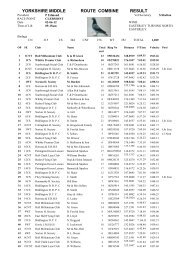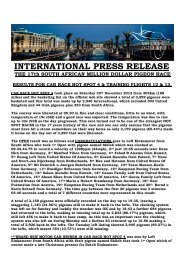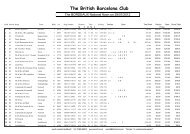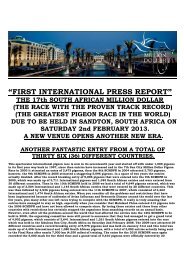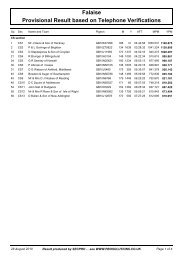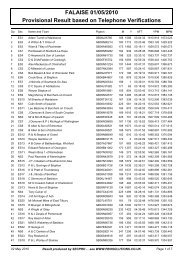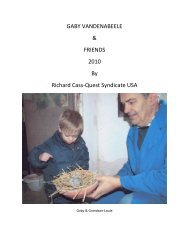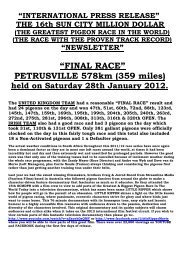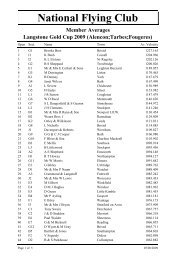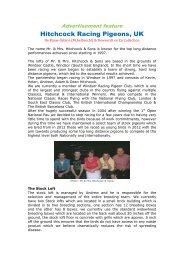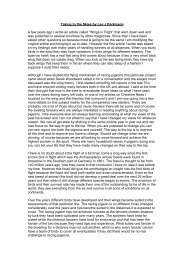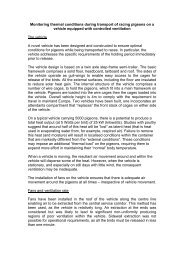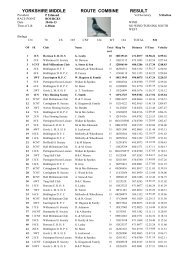May - Elimar Pigeon Services
May - Elimar Pigeon Services
May - Elimar Pigeon Services
You also want an ePaper? Increase the reach of your titles
YUMPU automatically turns print PDFs into web optimized ePapers that Google loves.
MONTH BY MONTH<br />
with Chris<br />
Champion “Tracey’s Red” winner of the N.W.C.C.<br />
Hall of Fame and over £5,000 in his racing career,<br />
for Chris Knowles of Woodley, Stockport.<br />
<strong>May</strong> -- Maia's month<br />
Old French for <strong>May</strong> is Mai, Old English for <strong>May</strong> is Maius and the Latin Maius means "of Maia", Latin Maius<br />
mensis "month of Maia". Maius has always had 31 days. Maia (meaning "the great one") is the Italic<br />
goddess of spring, the daughter of Faunus, and wife of Vulcan.<br />
<strong>May</strong> to me is the month where I believe I must concentrate on and apply the knowledge that I have aquired<br />
over many years, to “Muscle Management”. In April I referred to “Fitness” which I described as<br />
distribution of oxygen to muscle tissue during increased exercise and condition of body or mind<br />
Many informative articles have been published or made available via the Internet, on the subject of how the<br />
muscle structure of pigeons is made up and works, along with essential information in relation to the<br />
benefits to be gained when your feeding protocol is right. The author that I have found to be excellent in<br />
this field and who presents his information in a very user friendly way is Gordon A. Chalmers, DVM. I would<br />
strongly recommend that anyone interested and who has not already read his works, should do so.<br />
This month sees the beginning of races from France to my part of the country and is a key time for<br />
exercising youngsters to ensure development of their vital organs and to increase their fitness in readiness<br />
for the approaching season and along with it, their training.<br />
Youngsters enjoying their daily exercise on one of the days where the weather was O.K. To use the<br />
camera.
This picture illustrates well one of the major benefits of the darkness system with Ybs, as you can see the<br />
complete body covering of feathers on these youngsters and how they are using their full wings to best<br />
advantage during flight.<br />
From the picture above you can see how different birds are using both wings and tails in various ways as<br />
they are propelled along by the major pectoral muscles which lie either side of the breast bone and make<br />
up from 20-32% of the total weight of the pigeon. The main function of these muscles, is to pull the wing<br />
through the powerful down stroke, which propels the pigeon forward and provides lift. Other important flight<br />
muscles are the much smaller and more deeply located pectorals, sometimes called the minor pectorals.<br />
These small muscles have the important function of raising and rotating the wing during flight and make up<br />
only about 4-5% of the weight of the pigeon. Between them, the actions of these two sets of muscles<br />
ensure that the wings are raised and lowered. They have on average, a beat of 5.4 times a second at<br />
cruising speed for the duration of the flight. In contrast, during the short, explosive phase following strike<br />
off, the wings beat on average at the rate of 9.5 times per second. Such information and much more can be<br />
found in the articles of Dr. Chalmers.<br />
As I have now reached the point of the season where I consider that my pigeons have reached the fitness<br />
level that I was seeking, I no longer use road training unless I have a pigeon or two that have been injured<br />
and I am trying to get them back to a fitness level, so that they may be raced. My exercising regime, is<br />
twice per day for cocks and hens and once per day for a minimum of one hour for my youngsters. I try to<br />
use common sense when the weather is inclement and will tend to adjust my feeding slightly, up or down to<br />
combat missed exercising or cold and humid snaps. It is not possible to define such changes as I go with<br />
my instinct. The exercising of my old birds is also to a degree done by feel and observation and the length<br />
of exercise is determined by the weather, the body language of the pigeons and the point in the week in<br />
relation to the last race and the upcoming race. On average each period of exercise is between 30 mins. at<br />
the beginning of the week to an hour at the end of the week. I also like to give my pigeons a short fly the<br />
morning after channel races to help prevent tying up or cramping in their muscles. I think that confinement<br />
after testing races can easily cause problems with the muscles which can then only be rectified with the<br />
elapse of time, a luxury that is not so readily available in the race season.
This picture, taken of my old cocks at exercise, shows how the air pressure beneath the wing causes the<br />
outer primaries to flex upwards, demonstrating the work required from the major pectorals, even when<br />
only at stress free exercise.<br />
Another excellent article which relates totally to all of this, is also from the pen of Dr. Chalmers, “The fuel<br />
for flight”. The relativity between carbohydrates, fats, glucose, fructose and a number of other substances,<br />
is essential information when combined with knowledge of the process inside the pigeon where food is<br />
converted into fuel where the liver has a major role to play. It is not practical for me to try to reproduce such<br />
information when it is readily available from a professional source but I would urge those who are not au fait<br />
with the knowledge, to take the time to read it. Assuming that a fancier has quality pigeons, he is wasting<br />
his/her time trying to win in the modern game, without a sound understanding of fuelling the engine and<br />
how the engine works.<br />
Coming back to myself, it is my quest in <strong>May</strong> to ensure that everything within my control is catered for in<br />
relation to managing the performance and efficiency of my pigeons in relation to their muscles. I have<br />
enjoyed more than my share of success in what I consider to be good competition over the years but I<br />
realise that it is harder than ever today because so much valuable information is available to everyone who<br />
cares to use it. Perhaps what differentiates between success and failure today, is more about good fanciers<br />
and not just good pigeons and finance, as it may have been some years ago?<br />
The season to date has been a series of fast races, which seems to becoming more of the norm. in recent<br />
seasons for the first part of the season. The NFC Fourgeres has been a good example with the winning<br />
velocities reaching over 1900 y.p.m. even when the pigeons started off in an east wind. Surely these<br />
weather trends must urge fanciers to seek a full understanding of feeding pigeons to achieve maximum<br />
muscle efficiency combined with optimum buoyancy, where body weight is not excessive and there is no<br />
negative energy balance at the time of basketing. Well I guess you will now fall into one of three categories,<br />
you are already aware of the drum that I am beating, you aren’t but you will sure make it your business to<br />
pursue the information, or you are just nor interested in which case I am wasting my time. Lets move on.
In this picture it is possible to see how the cocks are using their 8th, 9th and 10th primaries, especially<br />
the mealy pied cock centre picture and the dark grizzle bottom left. This shows the importance of quality<br />
feathers to the pigeon when in flight.<br />
I have included the above picture to hopefully illustrate that in addition to all other aspects that we have<br />
touched on, it is also important to work towards attaining the best quality feathering possible on your<br />
racers. I covered the value of regular bathing in last month’s article and I will stress it once again. In<br />
addition I supplement the feed for a couple of days per week with natural herbs to enhance the feather<br />
quality. This is something that my involvement with the showing of canaries many years ago taught me and<br />
is simple but something that I have never forgotten. The one thing that I have failed to mention which I also<br />
believe is a must have ingredient at this time of the season, is rest, “STRESS FREE REST”! If you have<br />
managed to cover all the other bases then the final piece of the jigsaw for me is rest.<br />
Yes you are correct!<br />
The one going in the<br />
wrong direction is an<br />
aeroplane, heading due<br />
west for Manchester<br />
airport and has just<br />
dropped his landing<br />
wheels as you can see.
This is a snap that I took of the beautiful little dove that sits her eggs in the Rhododendron hedge facing<br />
my loft, she has built about eight feet from the ground and sits on a very delicate nest of woven twigs. It is<br />
a delight to see the comings and goings of her and her mate and serves to remind me daily that we must<br />
not ignore mother nature and the wonders that she holds.<br />
There they go!<br />
And here they come!<br />
If that was all there is to it!!!<br />
Good friends are like stars.....<br />
You don't always see them,<br />
But you know they are always there.<br />
Until next month, Enjoy your pigeons! Chris K



